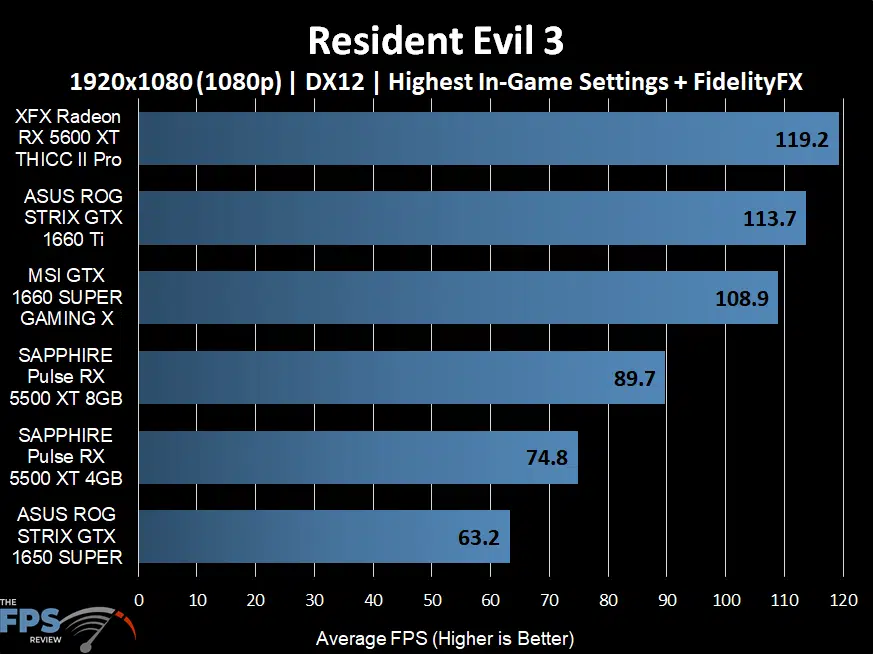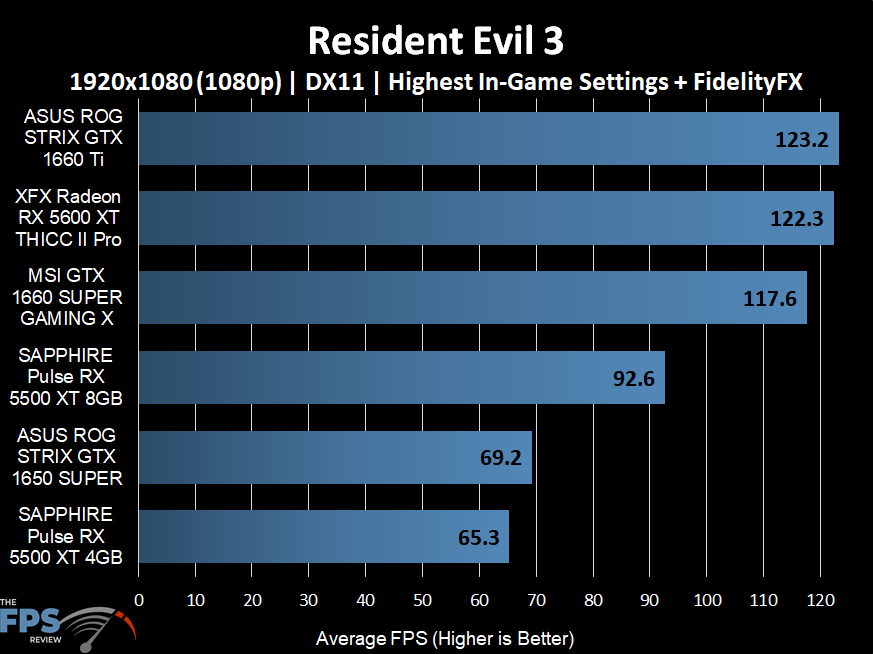1080p Performance
Finally, let’s look at the lower-end video cards at 1080p. Once again we have the game running at the highest in-game settings, only now we are running it at 1080p.
DX12

Right off the bat you’ll notice performance is also very good at 1080p, with very high playable framerates. The XFX Radeon RX 5600 XT THICC II Pro video card takes the cake and provides the highest performance compared to all the rest. It’s 5% faster than the ASUS ROG STRIX GeForce GTX 1660 Ti video card, which is a rather fast boosted factory overclocked video card btw. Both video cards have 6GB of VRAM and performance was smooth at these settings with no stuttering.
There does seem to be a large performance difference though between the MSI GeForce GTX 1660 SUPER and AMD’s Radeon RX 5500 XT video cards. Even though the SAPPHIRE Pulse Radeon RX 5500 XT 8GB has 8GB of VRAM, versus the GTX 1660 SUPER’s 6GB, the 1660 SUPER was 21% faster than the RX 5500 XT 8GB.
The two 4GB video cards suffered the most in performance. Notice that the SAPPHIRE PULSE Radeon RX 5500 XT 4GB is slower than the 8GB one. Both have the same clock speed, the only difference is VRAM capacity, yet the 8GB model is faster than the 4GB model by 20%. Then, the ASUS ROG STRIX GeForce GTX 1650 SUPER is the slowest, and it also has 4GB. This shows that VRAM capacity in this game can and does affect performance. The more the merrier.
However, even with this deficit, the game was playable on every single video card here in DX12 with the highest in-game settings. There was a little stuttering on the 4GB video cards though, but it was worse in DX11 than DX12. DX12 seemed to have smoothed out a lot of the stuttering we were getting with the Radeon RX 5500 XT 4GB.
DX11

Oh, look at this, moving to DX11 changes the landscape a bit. The XFX Radeon RX 5600 XT THICC II Pro is no longer the king, in DX11 the ASUS ROG STRIX GeForce GTX 1660 Ti takes the cake. It seems DX11 has improved performance more on the GTX 1660 Ti and puts it over the top now. Still, both are pretty much producing the same performance so it’s unnoticeable while gaming, they are now neck-and-neck.
Otherwise, everything looks good until we get down to the bottom cards. In DX12 the Radeon RX 5500 XT 4GB was beating the GeForce GTX 1650 SUPER. However, in DX11 the roles reverse. This is because in DX11 we had horrible stuttering and low framerates with the 4GB Radeon RX 5500 XT at these settings. This harmed the overall performance by a big deal. This is interesting because in DX12 this didn’t happen.
Our conclusion reveals that with the 4GB Radeon RX 5500 XT, we actually get much smoother and higher performance out of the video card in DX12. DX12 somehow is able to manage the memory better and creates less stuttering and rapid swings in performance. Under DX11, it’s a pretty bad gameplay experience with the video card. But under DX12, it is not. So if you have a 4GB Radeon RX 5500 XT, definitely play in DX12 for the best experience.
